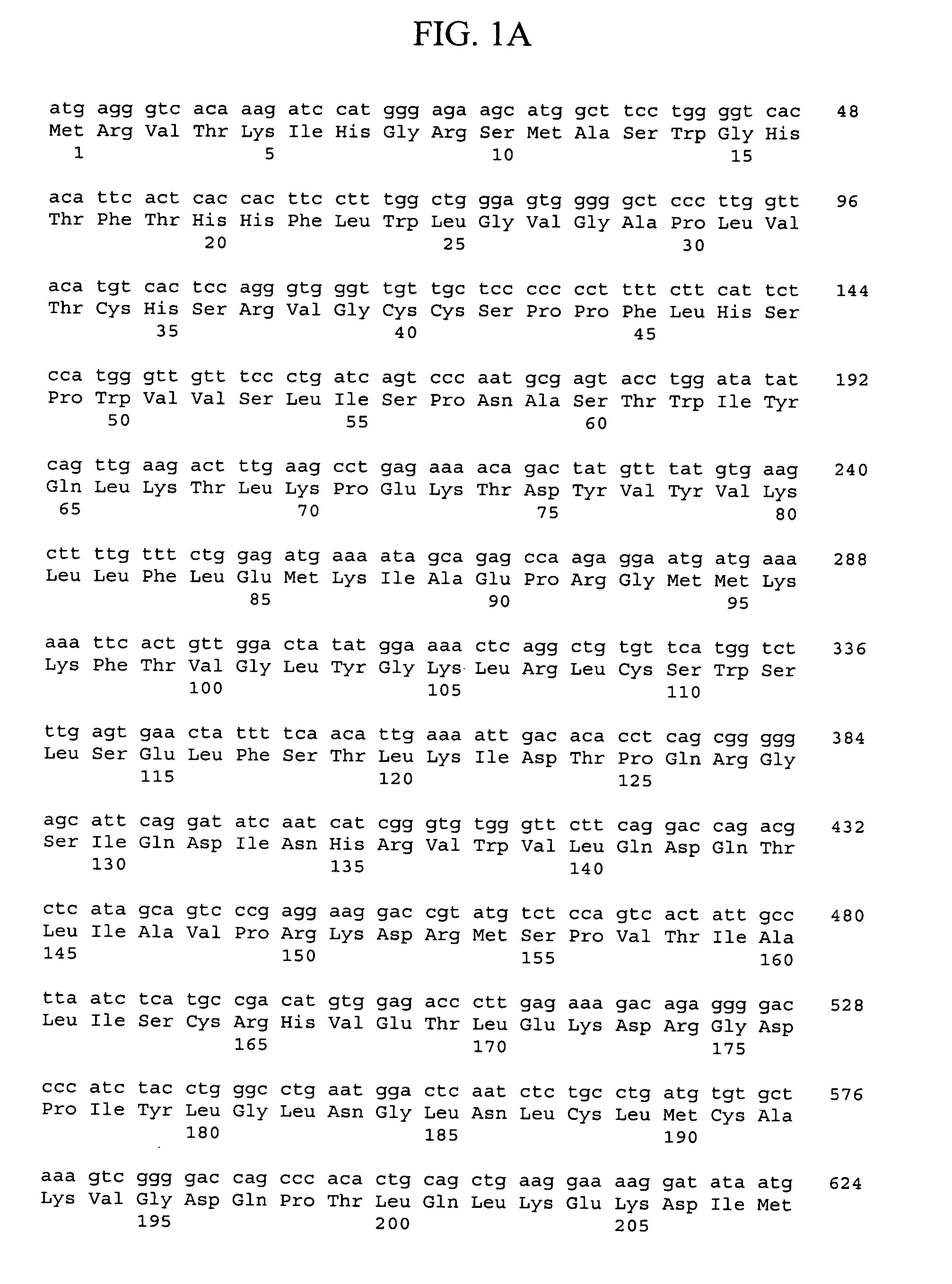Nucleic encoding interleukin-1 receptor antagonist-like proteins and uses thereof
a technology of interleukin-1 receptor and antagonistlike proteins, which is applied in the field of new interleukin-1 receptor antagonistlike (il1ral) polypeptides, can solve the problems that the potential for the development of novel therapeutics based on the human genome is still largely unrealized
- Summary
- Abstract
- Description
- Claims
- Application Information
AI Technical Summary
Benefits of technology
Problems solved by technology
Method used
Image
Examples
example 1
Cloning of the Human IL-1ra-L Polypeptide Gene
[0346] Generally, materials and methods as described in Sambrook et al. supra were used to clone and analyze genes encoding human IL-1ra-L polypeptides.
[0347] To isolate cDNA sequences encoding human IL-1ra-L polypeptide, homology-based BLAST searches of a human genomic database were performed. A 543 bp sequence (GA—9549109) identified in this manner was found to share sequence homology with human IL-1ra. Additional IL-1ra-L nucleic acid sequence information was derived from other genomic DNA sequences (GA—10432331 GA—10420243, GA—10004982, GA—11302507, GA—97234467; and GA—11641836). This sequence information was used to design gene specific oligonucleotides for the identification of cDNA sources and the generation of cDNA clones, using various PCR strategies.
[0348] A number of cDNA libraries were analyzed in amplification reactions containing 10 ng of cDNA library template DNA, 10 pmol each of the amplimers 2368-61 (5′-A-C-C-C-G-A-G-...
example 2
IL-1ra-L mRNA Expression
[0351] Multiple human tissue northern blots (Clontech) are probed with a suitable restriction fragment isolated from a human IL-1ra-L polypeptide cDNA clone. The probe is labeled with 32P-dCTP using standard techniques.
[0352] Northern blots are prehybridized for 2 hours at 42° C. in hybridization solution (5×SSC, 50% deionized formamide, 5× Denhardt's solution, 0.5% SDS, and 100 mg / ml denatured salmon sperm DNA) and then hybridized at 42° C. overnight in fresh hybridization solution containing 5 ng / ml of the labeled probe. Following hybridization, the filters are washed twice for 10 minutes at room temperature in 2×SSC and 0.1% SDS, and then twice for 30 minutes at 65° C. in 0.1×SSC and 0.1% SDS. The blots are then exposed to autoradiography.
[0353] The expression of IL-1ra-L mRNA is localized by in situ hybridization. A panel of normal embryonic and adult mouse tissues is fixed in 4% paraformaldehyde, embedded in paraffin, and sectioned at 5 μm. Sectioned ...
example 3
Production of IL-1ra-L Polypeptides
A. Expression of IL-1ra-L Polypeptides in Bacteria
[0355] PCR is used to amplify template DNA sequences encoding an IL-1ra-L polypeptide using primers corresponding to the 5′ and 3′ ends of the sequence. The amplified DNA products may be modified to contain restriction enzyme sites to allow for insertion into expression vectors. PCR products are gel purified and inserted into expression vectors using standard recombinant DNA methodology. An exemplary vector, such as pAMG21 (ATCC no. 98113) containing the lux promoter and a gene encoding kanamycin resistance is digested with Bam HI and Nde I for directional cloning of inserted DNA. The ligated mixture is transformed into an E. coli host strain by electroporation and transformants are selected for kanamycin resistance. Plasmid DNA from selected colonies is isolated and subjected to DNA sequencing to confirm the presence of the insert.
[0356] Transformed host cells are incubated in 2xYT medium conta...
PUM
 Login to View More
Login to View More Abstract
Description
Claims
Application Information
 Login to View More
Login to View More - R&D
- Intellectual Property
- Life Sciences
- Materials
- Tech Scout
- Unparalleled Data Quality
- Higher Quality Content
- 60% Fewer Hallucinations
Browse by: Latest US Patents, China's latest patents, Technical Efficacy Thesaurus, Application Domain, Technology Topic, Popular Technical Reports.
© 2025 PatSnap. All rights reserved.Legal|Privacy policy|Modern Slavery Act Transparency Statement|Sitemap|About US| Contact US: help@patsnap.com


